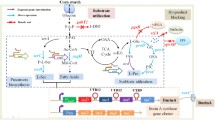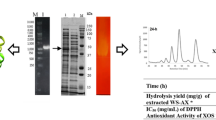Abstract
Developing a Komagataella phaffii (K. phaffii, named as Pichia pastoris formerly) medium using wheat bran hydrolysate (WBH) is a potential approach for wheat bran utilization and heterologous protein by K. phaffii because K. phaffii is used as protein producer by researchers and engineers widely. In this research, the detoxification process of WBH was optimized to obtain the final procedure as pH adjusting to 10 by calcium hydroxide addition, then, 2.0 g/L active carbon absorption followed by 1 h shaking and 3,600 × g centrifugation for 10 min, finally, 3.75 mmol/L sodium thiosulfate addition for 10 min shaking followed by 3,600 × g centrifugation for 10 min. Recombinant K. phaffii-xynB harboring xylanase B gene from Aspergillus niger ATCC 1015 under alcohol oxidase 1 promoter (PAOX1) was cultivated in detoxified WBH expressing 1059.8 U/mL xylanase B which was 90.9% of that in complex medium from Pichia protocols. These researches built a solid base for detoxified WBH as a low-cost medium of K. phaffii to express heterologous protein, also provided a bright outlet for wheat bran utilization.






Similar content being viewed by others
References
Ahmad M, Hirz M, Pichler H, Schwab H (2014) Protein expression in Pichia pastoris: recent achievements and perspectives for heterologous protein production. Appl Microbiol Biotechnol 98(12):5301–5317. https://doi.org/10.1007/s00253-014-5732-5
Schwarzhans JP, Luttermann T, Geier M, Kalinowski J, Friehs K (2017) Towards systems metabolic engineering in Pichia pastoris. Biotechnol Adv 35(6):681–710. https://doi.org/10.1016/j.biotechadv.2017.07.009
Pena D, Gasser B, Zanghellini J, Steiger M, Mattanovich D (2018) Metabolic engineering of Pichia pastoris. Metab Eng 50:2–15. https://doi.org/10.1016/j.ymben.2018.04.017
Zhu T, Sun H, Wang M, Li Y (2019) Pichia pastoris as a versatile cell factory for the production of industrial enzymes and chemicals: Current status and future perspectives. Biotechnol J 14(6):1800694. https://doi.org/10.1002/biot.201800694
Hahn-Hägerdal B, Karhumaa K, Larsson CU, Gorwa-Grauslund M, Görgens J, van Zyl WH (2005) Role of cultivation media in the development of yeast strains for large scale industrial use. Microb Cell Fact 4:31–31. https://doi.org/10.1186/1475-2859-4-31
Higgins DR, Cregg JM (1998) Pichia protocols, vol 103. Springer
Matthews CB, Kuo A, Love KR, Love JC (2018) Development of a general defined medium for Pichia pastoris. Biotechnol Bioeng 115(1):103–113. https://doi.org/10.1002/bit.26440
Plantz BA, Nickerson K, Kachman SD, Schlegel VL (2007) Evaluation of metals in a defined medium for Pichia pastoris expressing recombinant β-galactosidase. Biotechnol Prog 23(3):687–692. https://doi.org/10.1021/bp060332t
Wang J, Nguyen V, Glen J, Henderson B, Saul A, Miller LH (2005) Improved yield of recombinant merozoite surface protein 3 (MSP3) from Pichia pastoris using chemically defined media. Biotechnol Bioeng 90(7):838–847. https://doi.org/10.1002/bit.20491
Hélène B, Céline L, Patrick C, Fabien R, Christine V, Yves C, Guy M (2001) High-level secretory production of recombinant porcine follicle-stimulating hormone by Pichia pastoris. Process Biochem 36(8):907–913. https://doi.org/10.1016/S0032-9592(00)00296-X
Zhang J, Mao H, Li M, Su E (2019) Cyclodextrin glucosyltransferase immobilization on polydopamine-coated Fe3O4 nanoparticles in the presence of polyethyleneimine for efficient β-cyclodextrin production. Biochem Eng J 150:107264. https://doi.org/10.1016/j.bej.2019.107264
Zhang JG, Zhang Y, Li ML (2017) High-level secretion and characterization of cyclodextrin glycosyltransferase in recombinant Komagataella phaffii. J Biotechnol 259:126–134. https://doi.org/10.1016/j.jbiotec.2017.07.031
Debiagi F, Madeira TB, Nixdorf SL, Mali S (2020) Pretreatment efficiency using autoclave high-pressure steam and ultrasonication in sugar production from liquid hydrolysates and access to the residual solid fractions of wheat bran and oat hulls. Appl Biochem Biotechnol 190(1):166–181. https://doi.org/10.1007/s12010-019-03092-0
Palmqvist E, Hahn-Hägerdal B (2000) Fermentation of lignocellulosic hydrolysates. I: inhibition and detoxification. Bioresource Technol 74(1):17–24. https://doi.org/10.1016/S0960-8524(99)00160-1
Jönsson LJ, Alriksson B, Nilvebrant N-O (2013) Bioconversion of lignocellulose: inhibitors and detoxification. Biotechnol Biofuels 6(1):16. https://doi.org/10.1186/1754-6834-6-16
Eken-Saraçoğlu N, Arslan Y (2000) Comparison of different pretreatments in ethanol fermentation using corn cob hemicellulosic hydrolysate with Pichia stipitis and Candida shehatae. Biotech Lett 22(10):855–858. https://doi.org/10.1023/A:1005663313597
Lee JM, Venditti RA, Jameel H, Kenealy WR (2011) Detoxification of woody hydrolyzates with activated carbon for bioconversion to ethanol by the thermophilic anaerobic bacterium Thermoanaerobacterium saccharolyticum. Biomass Bioenerg 35(1):626–636. https://doi.org/10.1016/j.biombioe.2010.10.021
Alriksson B, Cavka A, Jönsson LJ (2011) Improving the fermentability of enzymatic hydrolysates of lignocellulose through chemical in-situ detoxification with reducing agents. Biores Technol 102(2):1254–1263. https://doi.org/10.1016/j.biortech.2010.08.037
Deng F, Cheong D-Y, Aita GM (2018) Optimization of activated carbon detoxification of dilute ammonia pretreated energy cane bagasse enzymatic hydrolysate by response surface methodology. Ind Crops Prod 115:166–173. https://doi.org/10.1016/j.indcrop.2018.02.030
Eryasar-Orer K, Karasu-Yalcin S (2021) Optimization of activated charcoal detoxification and concentration of chestnut shell hydrolysate for xylitol production. Biotech Lett 43(6):1195–1209. https://doi.org/10.1007/s10529-021-03087-0
Dhiman S, Mukherjee G (2018) Recent advances and industrial applications of microbial xylanases: a review. In: Gehlot P, Singh J (eds) Fungi and their role in sustainable development: current perspectives. Springer, pp 329–348
Liu T, Zhang J (2018) High-level expression and characterization of Aspergillus niger ATCC 1015 xylanase B in Komagataella phaffii. Appl Biol Chem 61(4):373–381. https://doi.org/10.1007/s13765-018-0368-2
Feng HJB, Jianguo Z (2018) Optimization of wheat bran acid pretreatment by response surface methodology. Chinese J Bioproc Eng 16(4):65–71
Dong J-J, Han R-Z, Xu G-C, Gong L, Xing W-R, Ni Y (2018) Detoxification of furfural residues hydrolysate for butanol fermentation by Clostridium saccharobutylicum DSM 13864. Biores Technol 259:40–45. https://doi.org/10.1016/j.biortech.2018.02.098
Mendez AJ, Cabeza C, Hsia SL (1986) A fluorometric method for the determination of triglycerides in nanomolar quantities. Anal Biochem 156(2):386–389. https://doi.org/10.1016/0003-2697(86)90269-1
Miller GL (1959) Use of dinitrosalicylic acid reagent for determination of reducing sugar. Anal Chem 31(3):426–428. https://doi.org/10.1021/ac60147a030
Zha Y, Westerhuis JA, Muilwijk B, Overkamp KM, Nijmeijer BM, Coulier L, Smilde AK, Punt PJ (2014) Identifying inhibitory compounds in lignocellulosic biomass hydrolysates using an exometabolomics approach. BMC Biotechnol 14(1):22. https://doi.org/10.1186/1472-6750-14-22
Taherzadeh MJ, Gustafsson L, Niklasson C, Liden G (2000) Physiological effects of 5-hydroxymethylfurfural on Saccharomyces cerevisiae. Appl Microbiol Biotechnol 53(6):701–708. https://doi.org/10.1007/s002530000328
Almeida JR, Bertilsson M, Gorwa-Grauslund MF, Gorsich S, Liden G (2009) Metabolic effects of furaldehydes and impacts on biotechnological processes. Appl Microbiol Biotechnol 82(4):625–638. https://doi.org/10.1007/s00253-009-1875-1
Li YC, Mitsumasu K, Gou ZX, Gou M, Tang YQ, Li GY, Wu XL, Akamatsu T, Taguchi H, Kida K (2016) Xylose fermentation efficiency and inhibitor tolerance of the recombinant industrial Saccharomyces cerevisiae strain NAPX37. Appl Microbiol Biotechnol 100(3):1531–1542. https://doi.org/10.1007/s00253-015-7167-z
Paes BG, Steindorff AS, Formighieri EF, Pereira IS, Almeida JRM (2021) Physiological characterization and transcriptome analysis of Pichia pastoris reveals its response to lignocellulose-derived inhibitors. AMB Exp. https://doi.org/10.1186/s13568-020-01170-9
Palmqvist E, Hahn-Hägerdal B (2000) Fermentation of lignocellulosic hydrolysates. II: inhibitors and mechanisms of inhibition. Bioresource Technol 74(1):25–33. https://doi.org/10.1016/S0960-8524(99)00161-3
Heer D, Sauer U (2008) Identification of furfural as a key toxin in lignocellulosic hydrolysates and evolution of a tolerant yeast strain. Microb Biotechnol 1(6):497–506. https://doi.org/10.1111/j.1751-7915.2008.00050.x
Feron VJ, Til HP, de Vrijer F, Woutersen RA, Cassee FR, van Bladeren PJ (1991) Aldehydes: occurrence, carcinogenic potential, mechanism of action and risk assessment. Mutat Res 259(3–4):363–385. https://doi.org/10.1016/0165-1218(91)90128-9
Lu Z-Y, Zhong J-J (2020) Effect of furfural addition on validamycin-A production in fermentation of Streptomyces hygroscopicus 5008. Process Biochem 92:43–48. https://doi.org/10.1016/j.procbio.2020.03.002
Yi X, Lin L, Mei J, Wang W (2021) Transporter proteins in Zymomonas mobilis contribute to the tolerance of lignocellulose-derived phenolic aldehyde inhibitors. Bioprocess Biosyst Eng 44(9):1875–1882. https://doi.org/10.1007/s00449-021-02567-x
Modig T, Lidén G, Taherzadeh MJ (2002) Inhibition effects of furfural on alcohol dehydrogenase, aldehyde dehydrogenase and pyruvate dehydrogenase. Biochem J 363(Pt 3):769–776. https://doi.org/10.1042/0264-6021:3630769
Banerjee N, Bhatnagar R, Viswanathan L (1981) Inhibition of glycolysis by furfural in Saccharomyces cerevisiae. Eur J Appl Microbiol Biotechnol 11(4):226–228. https://doi.org/10.1007/BF00505872
Carmel-Harel O, Storz G (2000) Roles of the glutathione- and thioredoxin-dependent reduction systems in the Escherichia coli and Saccharomyces cerevisiae responses to oxidative stress. Annu Rev Microbiol 54:439–461. https://doi.org/10.1146/annurev.micro.54.1.439
Grant CM, Collinson LP, Roe J-H, Dawes IW (1996) Yeast glutathione reductase is required for protection against oxidative stress and is a target gene for yAP-1 transcriptional regulation. Mol Microbiol 21(1):171–179. https://doi.org/10.1046/j.1365-2958.1996.6351340.x
Sigler K, Chaloupka J, Brozmanová J, Stadler N, Höfer M (1999) Oxidative stress in microorganisms—I. Folia Microbiol 44(6):587–624. https://doi.org/10.1007/BF02825650
Liu ZL (2006) Genomic adaptation of ethanologenic yeast to biomass conversion inhibitors. Appl Microbiol Biotechnol 73(1):27–36. https://doi.org/10.1007/s00253-006-0567-3
Probst KV, Vadlani PV (2015) Production of single cell oil from Lipomyces starkeyi ATCC 56304 using biorefinery by-products. Biores Technol 198:268–275. https://doi.org/10.1016/j.biortech.2015.09.018
Millati R, Niklasson C, Taherzadeh MJ (2002) Effect of pH, time and temperature of overliming on detoxification of dilute-acid hydrolyzates for fermentation by Saccharomyces cerevisiae. Process Biochem 38(4):515–522. https://doi.org/10.1016/S0032-9592(02)00176-0
Arminda M, Josúe C, Cristina D, Fabiana S, Yolanda M (2021) Use of activated carbons for detoxification of a lignocellulosic hydrolysate: Statistical optimisation. J Environ Manag 296:113320. https://doi.org/10.1016/j.jenvman.2021.113320
Zhang J, Zhao Y, Li M, Liu T (2019) Optimization of defined medium for recombinant Komagataella phaffii expressing cyclodextrin glycosyltransferase. Biotechnol Prog 35(5):e2867. https://doi.org/10.1002/btpr.2867
Acknowledgements
Project supported by the National Natural Science Foundation of China (No. 31870045).
Author information
Authors and Affiliations
Corresponding author
Ethics declarations
Conflict of interest
All authors declare they have no other competing interests.
Ethical statement
This article does not contain any studies with human participants or animals performed by any of the authors.
Additional information
Publisher's Note
Springer Nature remains neutral with regard to jurisdictional claims in published maps and institutional affiliations.
Rights and permissions
About this article
Cite this article
Zhou, Z., Zhou, H. & Zhang, J. Development of wheat bran hydrolysate as Komagataella phaffii medium for heterologous protein production. Bioprocess Biosyst Eng 44, 2645–2654 (2021). https://doi.org/10.1007/s00449-021-02633-4
Received:
Accepted:
Published:
Issue Date:
DOI: https://doi.org/10.1007/s00449-021-02633-4




